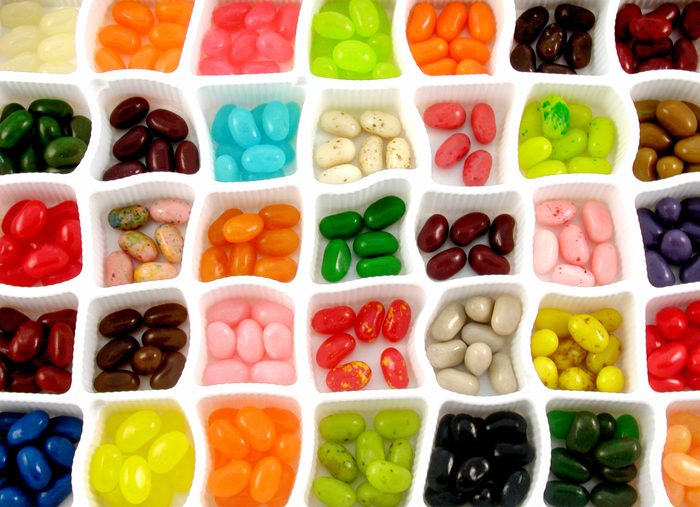We found juicy jelly bean trivia every candy lover needs to know

8 Sweet, Surprising Facts About Jelly Beans Every Candy Lover Should Know


1. It takes 7 to 21 days to make a jelly bean
Yep, you read that right. Concocting jelly beans requires many steps. First, liquid sugar is heated and mixed with starch and glucose. This is poured into bean-shaped starch molds and left to dry overnight. The next day, the starch is removed and the beans go through a steam bath and get sprayed with sugar. Next, they undergo what candy makers call “panning.” They’re put into a machine with a rotating drum, and while they spin, colors and flavors are added. Finally, grains of sugar are poured in—this sugar creates the bean’s hard shell. As a finishing touch, hot syrup and wax are applied to give shine. After all this shaking and making, the beans are thoroughly dried before they are packaged and shipped.

2. Although jelly beans were born in America, their roots may lie far, far East—in Turkey
Jelly beans first appeared in the United States in the mid-to-late 19th century. Some historians believe they were inspired by Turkish delight—a chewy jelly and powdered sugar confection that was a popular treat from Turkey.

3. Jelly bean was once used as slang for the kind of guy you don’t bring home to Mom and Dad
Some jelly bean facts you’d never guess: Back in the 1910s and 1920s, if you referred to a man as a jelly bean, you were calling him foolish, dishonest, a loafer, a womanizer or a gigolo. Ouch.

4. Jelly beans were originally enjoyed as a Christmas time treat
It took until the 1930s before jelly beans’ resemblance to eggs was noticed, and then they became a fixture in Easter baskets. However, the Yuletide association continues—after Easter, Christmas is still the So, an orange-ish bean could be Peach—or Barf (the vomit one). A green one might be Juicy Pear—or Booger. most popular time of year to eat them.

5. Ronald Reagan loved jelly beans so much he took them everywhere—the Oval Office, Air Force One … he even sent them into space!
In 1966, Ronald Reagan, then running for governor of California, started snacking on jelly beans from the Herman Goelitz Candy Company in his efforts to quit pipe smoking. While he stopped smoking, he developed a serious jelly bean jones. The company sent him regular shipments while he served as governor from 1967 to 1975. In 1976, Goelitz introduced the Jelly Belly brand of beans—their selling point was that both shell and interior are flavored (with other kinds of jelly beans, only the shell is flavored). Reagan became a big fan. After he was elected president, he kept a jar on his desk and handed out the candy as gifts. His favorite flavor? Licorice. A special jelly-bean jar holder was even installed for him on the presidential jet, and Reagan even sent beans on the Challenger space shuttle mission in 1983 as a treat for astronauts.

6. Reagan invented blueberry-flavored jelly beans
Well, he didn’t create them, but he did lead to their invention. For his January 1981 inauguration, Reagan ordered red, white and blue jelly beans to commemorate the event and be enjoyed during the celebrations. While it already manufactured red (Very Cherry) and white (Coconut) candies, it made no blue beans, so it came up with Blueberry. Three-and-a-half tons—or 40 million jelly beans—were consumed at the festivities. As president, Reagan had 720 bags containing 306,070 Jelly Belly beans delivered from Goelitz every month to Washington, D.C.

7. Two Jelly Belly flavors battled for most popular status
The candy brand Jelly Belly regularly releases jelly bean facts, and according to them, Very Cherry is now the favorite flavor of jelly bean. But it wasn’t always that way. Though it stayed on top for nearly two decades since its introduction in 1976, Very Cherry was knocked off its throne in 1998 by the Buttered Popcorn flavor (another fun fact: Buttered Popcorn is actually Jelly Belly’s most controversial flavor, with Licorice coming in second). But in 2003, Very Cherry reclaimed its title and it has been the favorite ever since.

8. Today, jelly beans come in a vast variety of flavors ranging from beer to vomit
The Jelly Belly company alone churns out more than 100 flavors. Some of the newest are Boba Milk Tea, Birthday Cake Remix, Pomegranate and Butterbeer. The company also offers a BeanBoozled box with 20 flavors: 10 classic and 10 gross-tasting lookalikes. So, an orange-ish bean could be Peach—or Barf (the vomit one). A green one might be Juicy Pear—or Booger. Blech. If you don’t feel brave enough to try a box with a cheeky name, you can find many, many YouTube videos in which participants challenge themselves to chew without gagging.
Why trust us
At Reader’s Digest, we’re committed to producing high-quality content by writers with expertise and experience in their field in consultation with relevant, qualified experts. We rely on reputable primary sources, including government and professional organizations and academic institutions as well as our writers’ personal experiences where appropriate. We’ve gone the extra step and had Marcy Lovitch, a fact-checker with 20-plus years of experience researching for national publications including Marie Claire, Good Housekeeping, Family Circle, Glamour, Seventeen, Real Simple, Forbes and InStyle magazines, verify that all quotes are attributed correctly and have credible sourcing. Read more about our team, our contributors and our editorial policies.
Sources:
- Today.com: “Here’s how jelly beans are made”
- Jelly Belly: “Origin of the Jelly Bean, or Why Are They Called Beans?”
- National Geographic: “A Bowl Full of Jelly Bean History”
- Britannica: “jelly bean”
- Reagan Library: “Jelly Belly Jelly Beans and Ronald Reagan”
- Jelly Belly: “Fun Facts”
- Time: “Here’s How Many Jelly Bellys Ronald Reagan Ate Each Month”
- Jelly Belly: “Gross, Weird and Nasty Flavors of Jelly Beans”




















